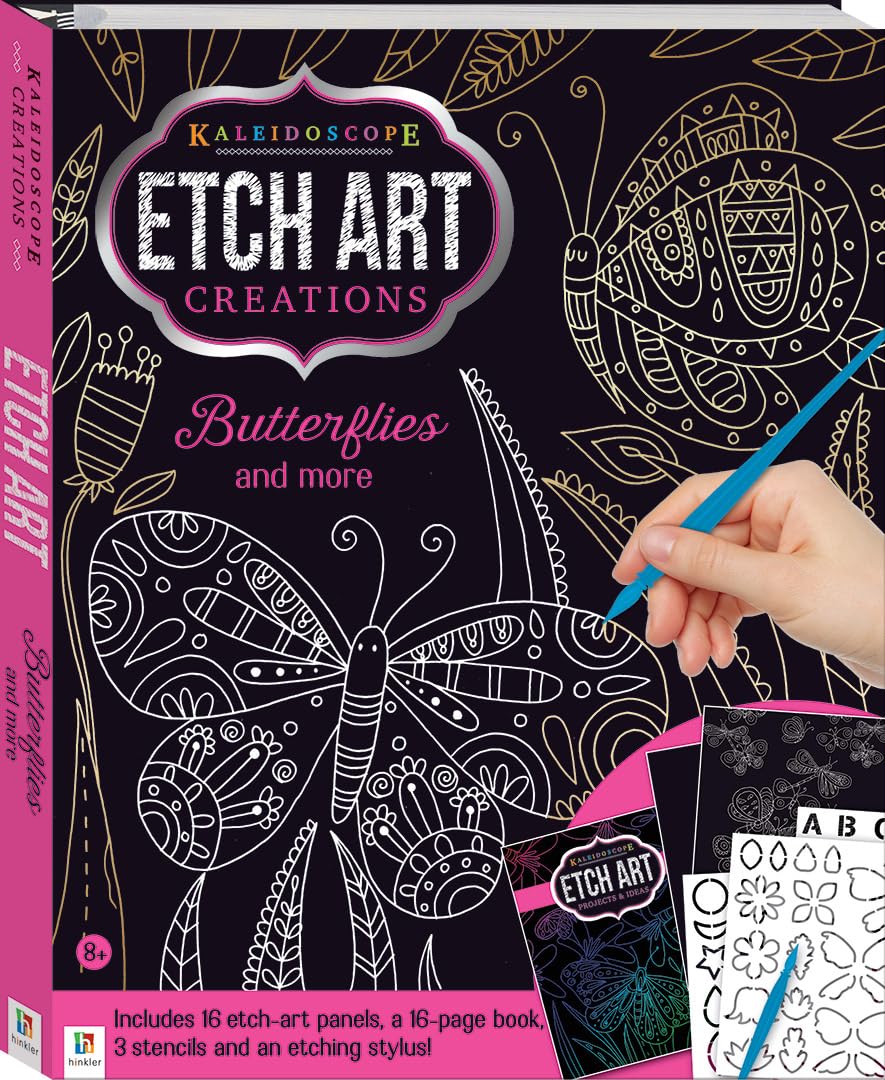About this deal
Enter a world of magic and wonder with Etch Art: Mythical Worlds! Create a magnificent dragon poster, a beautiful unicorn photo frame, a stunning phoenix bookmark and more using the etch-art panels and etching stylus!
Etching was used for decorating metal from the fourteenth century, but was probably not used for printmaking much before the early sixteenth century. Since then many etching techniques have been developed, which are often used in conjunction with each other: soft-ground etching uses a non-drying resist or ground, to produce softer lines; spit bite involves painting or splashing acid onto the plate; open bite in which areas of the plate are exposed to acid with no resist; photo-etching (also called photogravure or heliogravue) is produced by coating the printing plate with a light sensitive acid-resist ground and then exposing this to light to reproduce a photographic image. Foul biting results from accidental or unintentional erosion of the acid resist. Behr, Marion; Behr, Omri (1993), "Etching and Tone Creation Using Low-Voltage Anodic Electrolysis", Leonardo, 26 (#1): 53–, doi: 10.2307/1575781, JSTOR 1575781, S2CID 100716855 Traditional intaglio printmaking methods, their health hazards, new non-toxic substitutes". Greenart.info. 2013-03-14 . Retrieved 2015-08-11.Foul-bite or "over-biting" is common in etching, and is the effect of minuscule amounts of acid leaking through the ground to create minor pitting and burning on the surface. This incidental roughening may be removed by smoothing and polishing the surface, but artists often leave faux-bite, or deliberately court it by handling the plate roughly, because it is viewed as a desirable mark of the process. Designs in a syrupy solution of sugar or Camp Coffee are painted onto the metal surface prior to it being coated in a liquid etching ground or 'stop out' varnish. When the plate is placed in hot water the sugar dissolves, leaving the image. The plate can then be etched. The plate is then completely submerged in a solution that eats away at the exposed metal. ferric chloride may be used for etching copper or zinc plates, whereas nitric acid may be used for etching zinc or steel plates. Typical solutions are 1 part FeCl 3 to 1 part water and 1 part nitric to 3 parts water. The strength of the acid determines the speed of the etching process. Some of the earliest printmaking workshops experimenting with, developing and promoting nontoxic techniques include Grafisk Eksperimentarium, in Copenhagen, Denmark, Edinburgh Printmakers, in Scotland, and New Grounds Print Workshop, in Albuquerque, New Mexico. You can see innovative examples of etching in the works of master artists like Rembrandt van Rijn, Albrecht Dürer, and Francisco Goya. However, even if you’re familiar with the term “etching,” you might not know exactly what the process involves.
By working with a variety of trusted Range Plus Partners, we’re able to offer our customers a wider selection of products. Behr, Omri (1997), "An improved method for steelfacing copper etching plates", Leonardo, The MIT Press, 30 (#1): 47–48, doi: 10.2307/1576375, JSTOR 1576375, S2CID 139028601 With that in mind, we’ve put together this beginner’s introduction to etching, showing how artistic etchings are made. Our etching guide is illustrated by some visual aids we recorded while visiting Amsterdam’s remarkable Rembrandt House Museum a few years ago. Etching is also used in the manufacturing of printed circuit boards and semiconductor devices, and in the preparation of metallic specimens for microscopic observation. Growing concerns about the health effects of acids and solvents [19] [20] led to the development of less toxic etching methods [21] in the late 20th century. An early innovation was the use of floor wax as a hard ground for coating the plate. Others, such as printmakers Mark Zaffron and Keith Howard, developed systems using acrylic polymers as a ground and ferric chloride for etching. The polymers are removed with sodium carbonate (washing soda) solution, rather than solvents. When used for etching, ferric chloride does not produce a corrosive gas, as acids do, thus eliminating another danger of traditional etching.
During the etching process the printmaker uses a bird feather or similar item to wave away bubbles and detritus produced by the dissolving process, from the surface of the plate, or the plate may be periodically lifted from the acid bath. If a bubble is allowed to remain on the plate then it will stop the acid biting into the plate where the bubble touches it. Zinc produces more bubbles much more rapidly than copper and steel and some artists use this to produce interesting round bubble-like circles within their prints for a Milky Way effect. Draw on the etch-art panels with the stylus to uncover the bright foil or patterns underneath, making your creations burst with life! Etchings have been hugely influential in art history, particularly in the development of printmaking. US 5102520,Behr, Marion&Behr, Omri,"Electrolytic etching process and apparatus therefor",published 1992-04-07 . The voltage should be adjustable to operate accurately within a rather narrow voltage range, such that the minimum voltage shall be at least that of the ionization potential of the metal object in the electrolyte chosen and the maximum shall not substantially exceed the sum of the decomposition voltage of the aqueous electrolyte and the over-voltage of the cathode selected. The Artist's Studio: What Is Etching?" (PDF). Cairnsregionalgallery.com.au. Archived from the original (PDF) on 2015-09-06 . Retrieved 2015-08-12.
Jacques Callot (1592–1635) from Nancy in Lorraine (now part of France) made important technical advances in etching technique.After the ground has hardened the artist "smokes" the plate, classically with 3 beeswax tapers, applying the flame to the plate to darken the ground and make it easier to see what parts of the plate are exposed. Smoking not only darkens the plate but adds a small amount of wax. Afterwards the artist uses a sharp tool to scratch into the ground, exposing the metal.
 Great Deal
Great Deal 